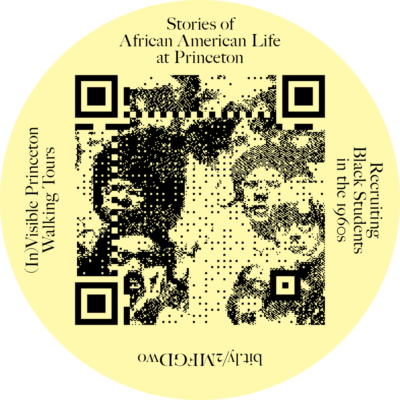Project Showcase: (In)Visible Princeton
08 January 2019 – Abby Klionsky

Image credit: Princeton University
As an institution older than the nation itself, Princeton University and its history often reflect social and political trends of the broader United States, as well as its patterns of exclusion and erasure. A new digital project, called (In)Visible Princeton, is one step toward confronting some of these historical injustices and helping Princeton reconcile the values of its past with the ones it embodies today.
(In)Visible Princeton is a series of mobile-friendly, themed historical walking tours that incorporate into the university’s historical narrative the stories and experiences of people whose voices have traditionally been excluded. In doing so, these tours not only provide opportunities for people to recognize their own stories in Princeton’s history; they actually make that narrative more accurate.
In confronting these aspects of the institution’s past, (In)Visible Princeton is part of a broader effort to diversify the art, iconography, and stories told on campus in a way that is more representative and inclusive of all members (and future members) of the community. This work began as a result of conversations between students, staff, faculty, and administrators about an honest accounting of the university’s complex history, and the subsequent recommendations generated by a review of Woodrow Wilson’s legacy on campus. It is part of a wave of colleges and universities seeking to be forthcoming about their own histories of exclusion and racial oppression, including initiatives at Columbia University, the University of Virginia, and the University of Wisconsin, as well as the ongoing Princeton & Slavery Project that went live in November 2017.
For generations, Princeton’s dominant historical narrative centered on its overwhelmingly white, male, and Christian body of students, alumni, and faculty. For the most part, the stories of people of color, women, and other historically marginalized groups were at best sidebars to the history of Princeton, and at worst not included at all. Through text, images, audio, videos, and external links, (In)visible Princeton offers a dynamic exploration of nearly 275 years of history. The project launched with four tours: Stories of African American Life at Princeton, Stories of “Firsts” at Princeton, Stories of Traditions at Princeton, and Stories of Women at Princeton.
The tours are advertised on campus by a collection of sidewalk stickers, which have QR codes that direct passersby to the stops. They are also included on the university’s information page for visitors as an alternative way to tour the campus. And, since they are entirely web-based, the tours are accessible both on campus and from afar.
In “Stories of Women at Princeton,” visitors learn about the women who took courses in the university’s engineering school in the 1940s, more than two decades before women were permitted to enroll as undergraduates. The tour also introduces female university librarians of the nineteenth century and recognizes the enslaved women who lived and worked on campus for the first century of the college’s existence.
Likewise, (In)Visible Princeton highlights manifestations of white supremacist ideology in the institution’s past. Consider the following vignettes: during the Reconstruction era, which held the promise of full and equal rights for black Americans, the presence of black men in a course taught by Princeton’s president prompted some white students to withdraw from the school. By 1922, Princeton implemented a new admissions process that hindered the enrollment of Jews and other minorities; two years later, the United States passed the Immigration Act of 1924, which set tight quotas on immigration from certain countries. More information on both episodes is available in the external links recommended by the tour at the end of each stop.
With stories like these finally woven into the fabric of the history, a more complete picture emerges of how the past has shaped the present and of how conversations about identity continue to shape students’ experiences at Princeton and the groups, teams, and organizations that they join. And from there, it’s possible to imagine building a future that includes from the start all those who couldn’t see themselves reflected in the past.
~ Abby Klionsky is currently a project specialist at Princeton University, where she oversees the (In)Visible Princeton initiative. She is a public historian and writer and has previously worked in curriculum development.



